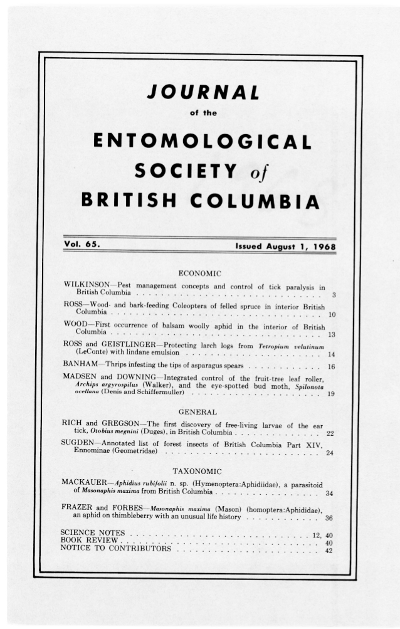Thrips infesting the tips of asparagus spear
Keywords:
onion thrips, <i>Thrips tabaci</i>, flower thrips, <i>Frankliniella tritici</i>Abstract
The onion thrips, <i>Thrips tabaci</i> Lind., and the flower thrips, <i>Frankliniella tritici</i> (Fitch), mainly from <i>varicornis</i> Bagnall, were found in the tips of asparagus spears from commercial fields in the southern interior of British Columbia. Both species occurred in about equal numbers except in one area, where <i>F. tritici</i> from <i>varicornis</i> was the more abundant species. Only adults were found. These migrant thrips do not damage the spears but are a potential source of contamination in the processed product. Thrips were most abundant in spears with loose or "blown" tips. In all areas the highest infestations of thrips in the spears occurred in fields with heavy weed cover. The weed cover and bordering forage crops, including alfalfa, provided a constant source of infestation. Increased numbers of thrips in spears coincided with increased daily temperatures and cutting of bordering forage crops. Effective weed control reduced the numbers of thrips infesting the spears.
References
Michelbacher, A.E. and O.G. Bacon. 1949. Thrips on asparagus. J. Econ. Entomol. 42:849-50.
Downloads
Published
Issue
Section
License
Authors who publish with the Journal of the Entomological Society of British Columbia agree to the following terms:
-Authors retain copyright and grant the journal right of first publication with the work simultaneously licensed under a Creative Commons Attribution License that allows others to share the work with an acknowledgement of the work's authorship and initial publication in this journal.
-Authors are able to enter into separate, additional contractual arrangements for the non-exclusive distribution of the journal's published version of the work (e.g., post it to an institutional repository or publish it in a book), with an acknowledgement of its initial publication in this journal.
-Authors are permitted and encouraged to post their work online (e.g., in institutional repositories or on their website) prior to and during the submission process, as it can lead to productive exchanges, as well as earlier and greater citation of published work (See The Effect of Open Access).


